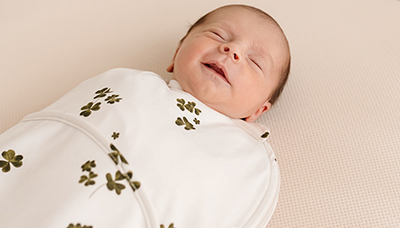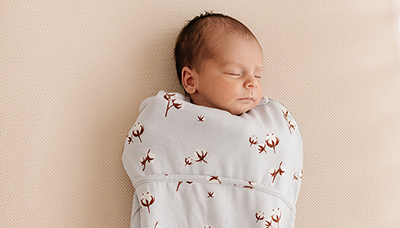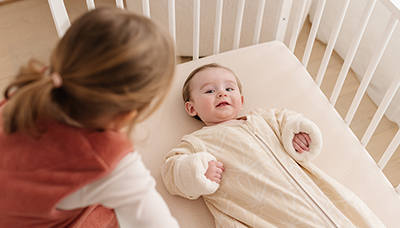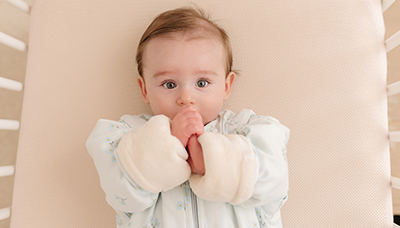Babies and sleep: a hot topic among new parents. Wondering what a sleep schedule might look like in other families at a certain age? How much sleep your little one needs? This blog will give you some guidelines for your baby's sleep schedule. But remember: every baby is different and the most important thing is your parental intuition. You'll always be the one in charge of finding a routine that works for you and your child. It's totally fine if that means you'll just keep doing what you're doing.
Index
- What is a good sleep schedule for my baby?
- What is the link between feeding and baby sleep?
- How do I recognize sleep cues?
- How to structure my baby's sleep patterns?
- What is the difference between active and deep sleep in newborn babies?
- When do babies develop circadian rhythms?
- What wake windows should I use?
- What should I know about my baby's sleep patterns?
- My baby has trouble sleeping through the night
- Daytime naps are difficult: how to help your baby fall asleep
- Example baby sleep schedule by age
Your baby's sleep schedule
What is a good sleep schedule for my baby?
Every newborn baby has their own sleep rhythm and everything changes quickly those first few weeks and months. Individual children's sleep patterns vary, although there are similarities. Babies sleep a lot, but it is quite natural for young babies to wake up regularly. What constitutes a good sleep schedule depends on your child's age and temperament. Most newborn babies do not yet distinguish much between day and night, but after a few months your child will get a reasonable circadian rhythm.
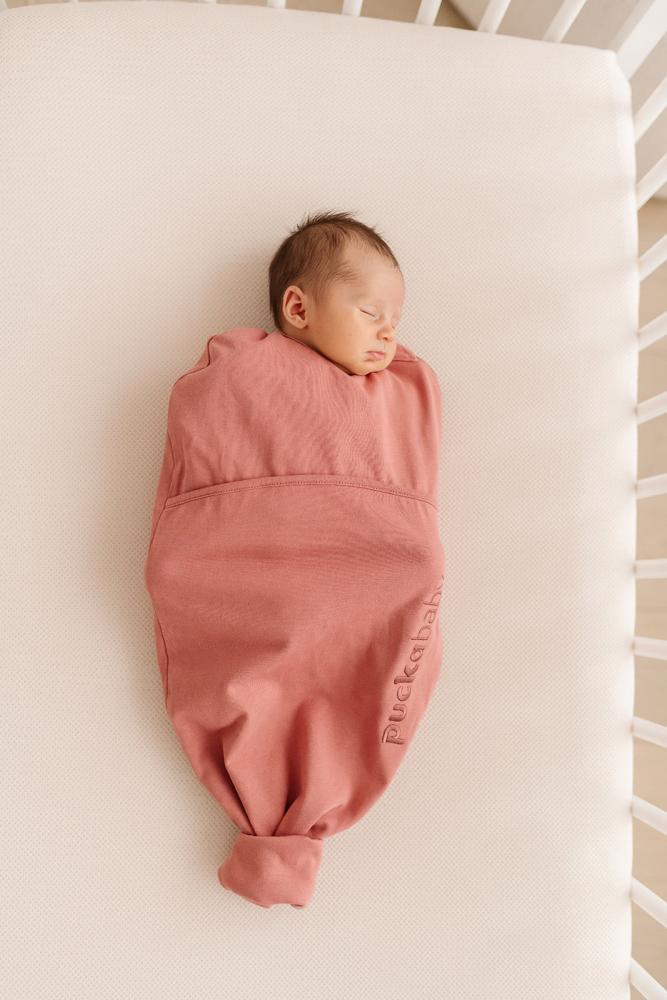

What is the link between feeding and baby sleep?
Newborn babies have tiny tummies and need a feeding every 2 to 4 hours, so they wake up every few hours and usually don't sleep through the night. Feeding is a leading factor in newborn sleep patterns.
Especially during the early weeks, breastfeeding on demand is beneficial for milk production. Some bottle-fed babies benefit as well from feeding on demand. And you've undoubtedly noticed: a baby who isn't properly awake doesn't drink well. There's no point in forcing it.
During the first 3 months, your baby's sleep schedule is determined by the routine of sleeping, eating, changing, cuddling and sleeping again. As your baby grows, she/he can stay awake a little longer and becomes interested in playtime. Feeding and sleep become less strictly linked to each other.
How do I recognize sleep cues?
As your child gets older, from about 6 to 7 months, food is less leading for sleep. Your baby's sleep cycles and wake windows become somewhat longer. Pay close attention to your baby's cues, in order to know when it is time for them to sleep.
- yawning
- rubbing the eyes
- looking away if you try to make contact
- whining
- crying
- staring
- clenching fists
- fidgeting with the ears
When you notice these signs, you know it's time to put your baby to sleep. An overtired baby may become upset and it may take longer for your child to fall asleep.
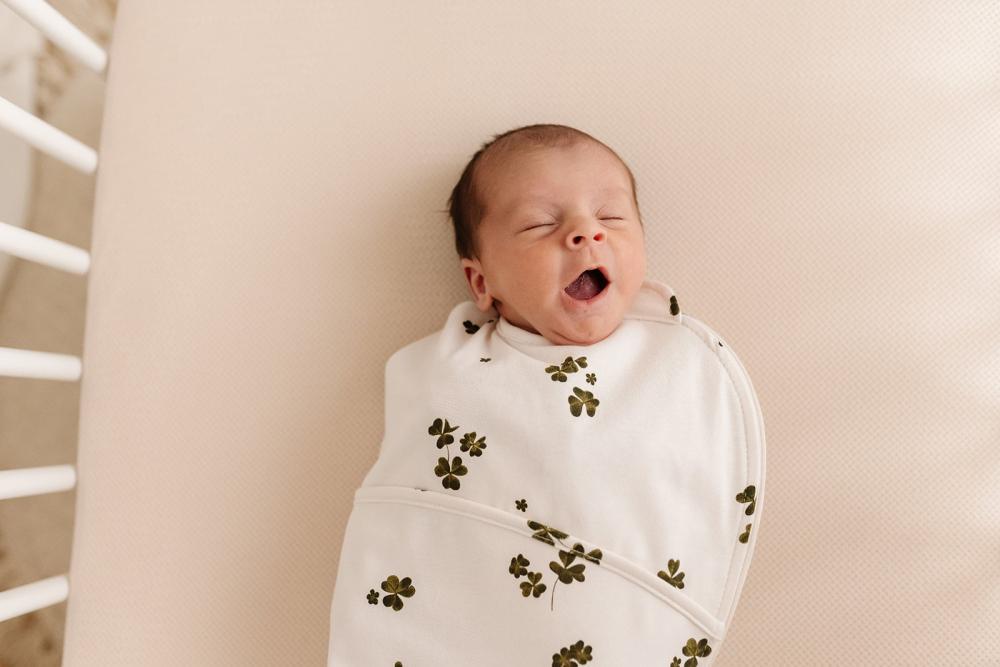

How to structure my baby's sleep patterns?
Would you like to add some structure to you and your baby's day? During the first few months, it is convenient to determine the time of the first and last feedings yourself. For example, you feed your baby around 7 a.m. In the evening, you can choose to give the last feed of the day around 11 p.m. (and any night feeds you give on demand).
Do you prefer not to interfere in your child's sleep pattern? That may mean you are feeding at very different times every day. That doesn't have to be a problem if it doesn't bother you. For many breastfeeding moms, it feels natural to follow the baby's rhythm. To meet your own sleep needs, it can be helpful to get some daytime sleep together with your baby.
What is the difference between active and deep sleep in newborn babies?
A total sleep cycle lasts about an hour for the first 6 months. So your baby usually goes through several sleep cycles during a nap. Sometimes your baby may appear to be "waking up" while just beginning the next active sleep phase. Therefore, a quiet environment during sleep may be important for your baby, while other babies benefit from white noise.
Babies go through a shorter sleep cycle than adults. Two sleep stages can be distinguished during sleep:
-
Active sleep (comparable to an adult's REM sleep)
In the active sleep phase, you see rapid eye movements, your baby sleeps superficially, moves its arms and legs, may laugh or cry briefly, and breathing is restless. Your baby still responds easily to outside stimuli such as sounds, touch and light. Newborns spend around half of their sleep time in REM. -
The quiet or deep sleep
When your baby transitions to the quiet sleep phase, you will notice deep, calm breathing. Your baby lies still and relaxed and wakes up less easily.
When do babies develop circadian rhythms?
When your baby is about 6 months, sleep patterns change. The difference between the day and nighttime becomes more obvious to your baby. This is due to the maturation process of the brain. Your baby will start sleeping for longer periods in a row at night. Even if your baby still wakes up at night for a feed, you will find that you will get more (consecutive) sleep in the coming months.
What wake windows should I use?
It can be interesting to know how long a baby can be awake on average. Of course, there are individual differences in little ones. Wake windows and sleep times also depend on the number of naps and their length.
During the first year, wake windows keep lengthening. When your little one is about a year old, the differences between children become more pronounced. One child likes one long afternoon nap and another needs three short naps during the day. This depends on your toddler's temperament and activity level. For example, some children nap more in daycare than at home. Don't let the clock be your only guide: keep paying attention to your child's sleep cues. That way, you will automatically notice how much sleep your little one needs.


What should I know about my baby's sleep patterns?
How much does a baby sleep on average? Like adults, sleep needs for babies vary and every little one has their own pattern. Here's what you can expect:
- 0-3 months
11 - 19 hours per 24 hours, usually 14 - 17 hours - 4-11 months
10 - 18 hours per 24 hours, usually 12 - 15 hours - 1 year
9 - 16 hours per 24 hours, usually 11 - 14 hours
What if my baby has sleep issues?
My baby has trouble sleeping through the night
Do you constantly hear other parents say how well their little one sleeps and is your experience different? Know that not everyone's sleep expectations are the same. Some parents don't need unbroken sleep to function. Your baby may have trouble sleeping or staying asleep because of illnesses, teething, growth spurts or sleep regression. There are also many babies who still need a night feed after the first few months. So frequent waking can be normal, but it is important to watch for red flags, such as:
- Hourly waking
- Sleeping with open mouth or snoring
- Gasping or pauses in breathing
- Being very upset when waking and needing a long time to settle
- Obvious discomfort or pain
- Feeding problems
- Physical symptoms such as rashes or eczema
- Problems with bowel movements such as frequent constipation
- Very restless legs when sleeping
Do you notice one or more signs in your baby or do you feel that something isn't right? Be sure to consult your doctor or paediatrician.
Daytime naps are difficult: how to help your baby fall asleep
Not every baby sleeps well in bed during the day. Some babies are easy to put down, while others wake up immediately upon touching their mattress. What if your baby sleeps poorly during the day? A nice baby carrier is the way to go. Your little one can peacefully fall asleep, snuggled up to you. Some babies like to nap in a bouncer, but what about a safe and ergonomic hammock? A baby hammock will gently bounce your baby to sleep and help your baby take long naps.
Example baby sleep schedule by age
If you are curious about baby sleep schedules, you can find inspiration here. Note: an ideal infant sleep schedule that works for every child unfortunately does not exist. Does your baby sleep at different times, but usually wake up cheerful? That's the most important thing. Flexibility can be a breath of fresh air for your baby and yourself.
Newborns sleep a lot. Because their biological clock is not yet properly tuned, they do not know the difference between day and night. A newborn sleep schedule consists of feeding, diaper change and sleeping again until the next feeding, day and night. For some babies, it works better to first change the diaper and then feed them. That way your newborn baby is more awake for the feeding and can continue sleeping peacefully when they fall asleep after the feed.
- 7:00 a.m.: feeding, changing, sleeping
- 10:00 a.m.: feeding, changing, sleeping
- 1:00 p.m.: feeding, changing, sleeping
- 4:00 p.m.: feeding, changing, sleeping
- 7:00 p.m.: feeding, changing, sleeping
- 10:00 p.m.: feeding, changing, sleeping
- + 1 to 2 night feeds on demand.
Tip for broken nights of newborn sleep:
It can be helpful to not look at the clock throughout the night. Try to create a soothing atmosphere for you and your baby at night. A red nightlight can help you and baby stay sleepy. Anything to avoid being up for hours at night, if possible.
In the period from 1 to 4 months of age, your baby sleeps a little longer between feedings. Your baby will also be awake a little longer after the feedings. Your little one can have fun with you on your lap or in the playpen, or you can challenge your baby with some tummy time.
- 7:00 a.m.: feeding
- 11:00 a.m.: feeding
- 3:00 p.m.: feeding
- 7:00 p.m.: feeding
- 11:00 p.m.: feeding
- + any night feedings on demand, most babies cannot yet sleep through the night without a feed.
In this period the late feedings may have dropped. The 7 p.m. feeding will then shift to a slightly later time. This can mean that your baby will take a nap late in the afternoon or in the early evening and then start the night.
During this period, your baby starts eating more solid food. Milk remains the main food until at least one year old. To give your baby structure, it may help to offer solid food as a "meal" 3 times a day. If your baby doesn't eat much yet, offer milk before or after the meal. For the sleep schedule, this often means that babies sleep a little longer twice a the day: in the morning and around noon. Later in the day, your baby will probably take a shorter nap, and after the last feeding (between 7 p.m. and 8 p.m.), it will begin its night.
Around this period, you may notice that the morning nap gets a little shorter and the afternoon nap a little longer. Your child will probably gradually switch from 3 to 2 naps. Because your child now sleeps less (often), she may be tired earlier than you expect based on your baby's previous sleep schedule. That's okay: give your baby something to eat and slowly start your bedtime routine.
Tip: a set bedtime routine can also be a valuable moment of rest and connection for you, especially with an older baby. An example of a bedtime routine: diaper change,putting on a cozy sleeping bag , closing the curtains together, briefly talking about the day, listening to soft music, giving a goodnight kiss, rocking...
Around 12 months, most babies still take two naps. Somewhere between 13 and 18 months of age, your child will slowly switch to one nap. This involves a transition period where your child will take one nap one day and two the next. On a two-nap day, bedtime will then fall later than on a one-nap day.


Gina Tiemessen & Yolanda Roos
Basic Parenting Expert
Gina and Yolanda both have over 25 years of experience as youth care nurses and were at the forefront of preventive care for 0-4 year olds. They specialize in basic care for infants and young children and are passionate about supporting young parents.





